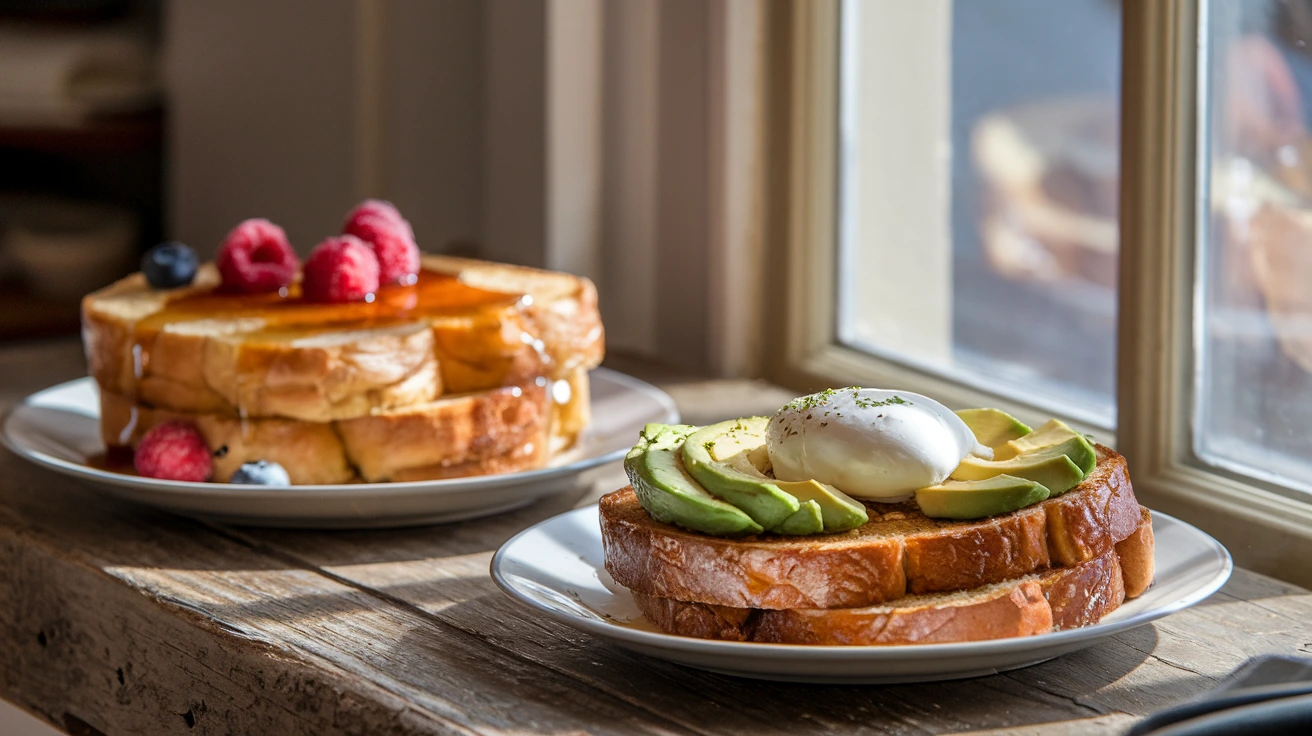Is sourdough or brioche better for French toast? French toast is a classic breakfast dish that combines simplicity with indulgence. From its origins as a way to use up stale bread to its transformation into a culinary delight, the type of bread you use plays a critical role in determining the flavor, texture, and overall quality of your French toast.
Among the many bread options available, sourdough and brioche stand out as two of the most popular choices. Brioche, with its rich and buttery profile, is often the go-to for sweet and decadent French toast recipes. On the other hand, sourdough’s tangy flavor and hearty texture offer a unique twist, appealing to those who prefer more balanced or savory option.
But which bread is better for French toast? The answer isn’t one-size-fits-all—it depends on your preferences, the type of French toast you’re making, and the toppings you plan to use. In this article, we’ll explore the key characteristics of sourdough and brioche, compare their strengths and limitations, and help you decide which bread is the best fit for your perfect French toast.
Whether you’re looking for a traditional sweet breakfast treat or experimenting with savory variations, understanding the differences between these two breads will elevate your French toast game. Let’s dive in!
What Makes the Perfect French Toast Bread: Sourdough or Brioche?
The secret to great French toast lies in the bread you choose. While custard preparation and cooking technique are important, the bread serves as the foundation for flavor and texture. Not all breads are created equal, and the best options share a few key characteristics that set them apart.
1. Flavor: Complementing the Custard and Toppings
The bread’s flavor should enhance the overall dish by working harmoniously with the sweet or savory elements of your French toast.
- Sweet Options: Breads like brioche naturally elevate the sweetness of French toast with their buttery richness.
- Tangy Options: Sourdough offers a bold, slightly sour flavor that contrasts beautifully with sweet toppings like maple syrup or powdered sugar. It also shines in savory French toast recipes.
- Neutral Options: White or challah bread provides a more neutral flavor, letting the custard and toppings take center stage.
Pro Tip: Choose bread that aligns with your recipe goals—brioche for a dessert-like experience or sourdough for a tangy, rustic twist.
2. Texture: Absorbing Custard Without Becoming Soggy
Bread with the right texture absorbs the custard evenly, ensuring a creamy interior without falling apart. Ideal French toast bread has:
- A Firm Structure: Sturdier breads like sourdough hold up well during soaking, preventing sogginess.
- A Soft Crumb: Breads like brioche soak up custard effortlessly, creating a melt-in-your-mouth texture.
- Slightly Stale Quality: Day-old bread is perfect for French toast because it absorbs custard better than fresh bread.
Pro Tip: If you’re using fresh bread, lightly toast it in the oven for 5–7 minutes at 300°F (150°C) to mimic the texture of day-old bread.
3. Versatility: Adapting to Sweet and Savory Recipes
The perfect bread should be adaptable, allowing you to create a variety of French toast dishes.
- Sweet Recipes: Brioche is the go-to choice for decadent, dessert-style French toast. Its buttery sweetness pairs wonderfully with syrup, whipped cream, and fresh fruits.
- Savory Recipes: Sourdough excels in savory variations, complementing toppings like avocado, bacon, and poached eggs.
- Creative Combinations: Versatile breads, like sourdough, offer opportunities to experiment with both sweet and savory flavors in one dish.
4. Structure: Holding Shape During Cooking
French toast bread must hold its shape when soaked in custard and cooked on a skillet. The ideal bread has:
- Thick Slices: Slices about ¾ to 1 inch thick are optimal, as they absorb custard evenly without falling apart.
- Balanced Density: Dense breads like sourdough work well for soaking, while softer options like brioche require careful handling to avoid tearing.
Why the Right Bread Matters
The bread you choose can make or break your French toast. A poorly chosen bread may result in soggy, flavorless, or structurally weak slices, while the right bread transforms this simple dish into a culinary masterpiece. By understanding the characteristics of great French toast bread, you can tailor your choice to fit your flavor preferences and recipe needs.
For more inspiration on using sourdough in breakfast recipes, visit Sourdough French Toast: A Breakfast Delight.
Exploring Sourdough for French Toast
Sourdough offers a completely different experience, bringing bold flavors and a rustic texture to your French toast.
Flavor Profile
- Sourdough is tangy and slightly sour, which contrasts beautifully with sweet toppings.
- Its flavor works equally well with savory accompaniments like eggs, bacon, or avocado.
Texture
- The dense crumb and firm crust absorb custard without becoming soggy, ensuring a hearty and satisfying bite.
- Its sturdiness makes it easier to handle during soaking and cooking.
Best Uses
- Sourdough is versatile and can be used in both sweet and savory French toast recipes.
- It’s perfect for creative dishes like herb-infused French toast or savory toppings with a poached egg.
Limitations
- The tangy flavor may not appeal to those who prefer sweeter bread.
- Its denser texture requires slightly longer soaking to fully absorb the custard.
Sourdough vs. Brioche: A Side-by-Side Comparison
When deciding between sourdough and brioche for French toast, it’s helpful to compare their qualities directly. Here’s how they stack up:
Flavor
- Brioche: Sweet, buttery, and rich. It naturally enhances the dessert-like elements of French toast, making it ideal for indulgent recipes.
- Sourdough: Tangy and complex. Its flavor contrasts beautifully with sweet toppings and pairs equally well with savory ingredients.
Texture
- Brioche: Soft and fluffy, creating a creamy interior but prone to becoming soggy if over-soaked.
- Sourdough: Dense and hearty, holding up well to custard without losing its structure.
Related Content: For more insights on using sourdough in French toast, visit Does Sourdough Taste Good as French Toast?.
Versatility
- Brioche: Best suited for sweet recipes, such as stuffed or caramelized French toast.
- Sourdough: Works in both sweet and savory dishes, offering more versatility.
Comparison Chart
| Feature | Brioche | Sourdough |
|---|---|---|
| Flavor | Sweet and buttery | Tangy and complex |
| Texture | Soft, creamy, can be delicate | Dense, sturdy, and chewy |
| Versatility | Ideal for sweet dishes | Great for both sweet and savory |
| Custard Absorption | Quick and thorough | Absorbs well but requires longer soaking |
Which Bread Should You Choose?
Can I Use Both Sourdough and Brioche in One Recipe?
Absolutely! Combining sourdough and brioche in a single recipe can create a unique and exciting French toast experience. This approach allows you to enjoy the best of both worlds: the tangy, chewy qualities of sourdough and the sweet, buttery softness of brioche. By layering or pairing these breads strategically, you can craft a French toast dish with complex flavors and textures.
1. Why Combine Sourdough and Brioche?
Using both breads brings a delightful contrast to your French toast:
- Flavor Depth: The tanginess of sourdough balances the sweetness of brioche, creating a more nuanced taste.
- Textural Variety: Brioche provides a soft, creamy bite, while sourdough adds chewiness and structure.
- Versatility: This combination works well for both sweet and savory recipes, depending on the custard and toppings used.
2. Recipe Ideas for Combining Sourdough and Brioche
Here are a few creative ways to use both breads in one French toast dish:
- Layered French Toast Casserole:
- Alternate layers of sourdough and brioche slices in a baking dish.
- Pour a custard mixture over the bread and let it soak.
- Bake until golden and serve with toppings like syrup, fresh fruit, or whipped cream.
- Check out Can You Make French Toast with Sourdough Bread? for more tips on working with sourdough.
- Stacked French Toast:
- Stack sourdough and brioche slices in a sandwich-style presentation.
- Fill the layers with cream cheese, jam, or Nutella for a sweet option.
- For savory combinations, add sliced avocado, cheese, or smoked salmon between layers.
- Sweet and Savory Platter:
- Prepare sourdough and brioche slices separately using different custard mixtures (e.g., a sweet vanilla custard for brioche and a savory herb-infused custard for sourdough).
- Serve together on a platter for a variety of flavors and styles in one meal.
3. Tips for Success
To ensure both breads shine in the recipe, follow these tips:
- Balance Soaking Times: Sourdough may need more time to soak in the custard compared to brioche. Adjust the soaking times accordingly to ensure both are evenly saturated.
- Use Similar Slice Thickness: Cut both breads to the same thickness (¾ to 1 inch) for consistent cooking.
- Pair Toppings Thoughtfully:
- Use tangy or savory toppings like crème fraîche, eggs, or bacon with sourdough slices.
- Pair sweet toppings like maple syrup or fruit compote with brioche slices.
4. When to Use This Combination
Combining sourdough and brioche is ideal for:
- Special Occasions: Impress guests with a layered or stacked French toast that showcases two distinct bread types.
- Brunch Menus: Offer a diverse breakfast platter that caters to different flavor preferences.
- Experimentation: Perfect for home cooks who enjoy experimenting with flavors and textures in classic recipes.
Frequently Asked Questions (FAQs)
1. Can I Make French Toast with Fresh Bread?
Yes, but day-old or slightly stale bread is ideal for French toast. Fresh bread absorbs custard unevenly and can become soggy. If you only have fresh bread, toast it lightly in the oven at 300°F (150°C) for 5–7 minutes to firm it up.
For sourdough tips, check out Can You Make French Toast with Sourdough Bread?.
2. Which Bread is Better for Sweet French Toast?
Brioche is the top choice for sweet French toast. Its buttery richness complements toppings like syrup, fresh fruit, and whipped cream. While sourdough can be used for sweet recipes, its tangy flavor is better suited for those who enjoy a contrast.
Learn more about sweet French toast in Sourdough French Toast: A Breakfast Delight.
3. Which Bread is Better for Savory French Toast?
Sourdough is ideal for savory French toast. Its tangy flavor pairs wonderfully with ingredients like avocado, bacon, and eggs. Brioche can also work in savory dishes but may lean toward sweetness.
For ideas on creating savory breakfasts, explore Breakfast Egg Rolls.
4. Can I Freeze French Toast?
Yes! Freezing French toast is a great way to prepare for busy mornings. Here’s how:
- Let cooked French toast cool completely.
- Lay slices in a single layer on a baking sheet and freeze until solid.
- Transfer the frozen slices to a freezer-safe bag or container with parchment paper between layers.
Reheating Tips:
- Use a toaster or oven at 375°F (190°C) for crispy edges.
- Warm slices in a skillet with butter for a freshly cooked taste.
5. How Do I Prevent French Toast from Becoming Soggy?
Avoid soggy French toast by following these tips:
- Use day-old bread with a sturdy texture.
- Soak slices in custard for only 5–10 minutes per side.
- Cook on medium heat to allow the custard to set inside while crisping the exterior.
Learn more about avoiding sogginess in Does Sourdough Taste Good as French Toast?.
6. Can I Combine Sourdough and Brioche in One Recipe?
Yes! Combining sourdough and brioche can create a unique and flavorful French toast experience. Use brioche for its softness and sweetness and sourdough for its tangy and chewy qualities. Layer them in a casserole or serve as a duo on the same plate.
For inspiration, check out Can You Make French Toast with Sourdough Bread?.
Conclusion
These FAQs provide practical tips and insights for creating the perfect French toast with sourdough or brioche. Whether you prefer sweet or savory dishes, both breads offer unique qualities that can elevate your breakfast.

